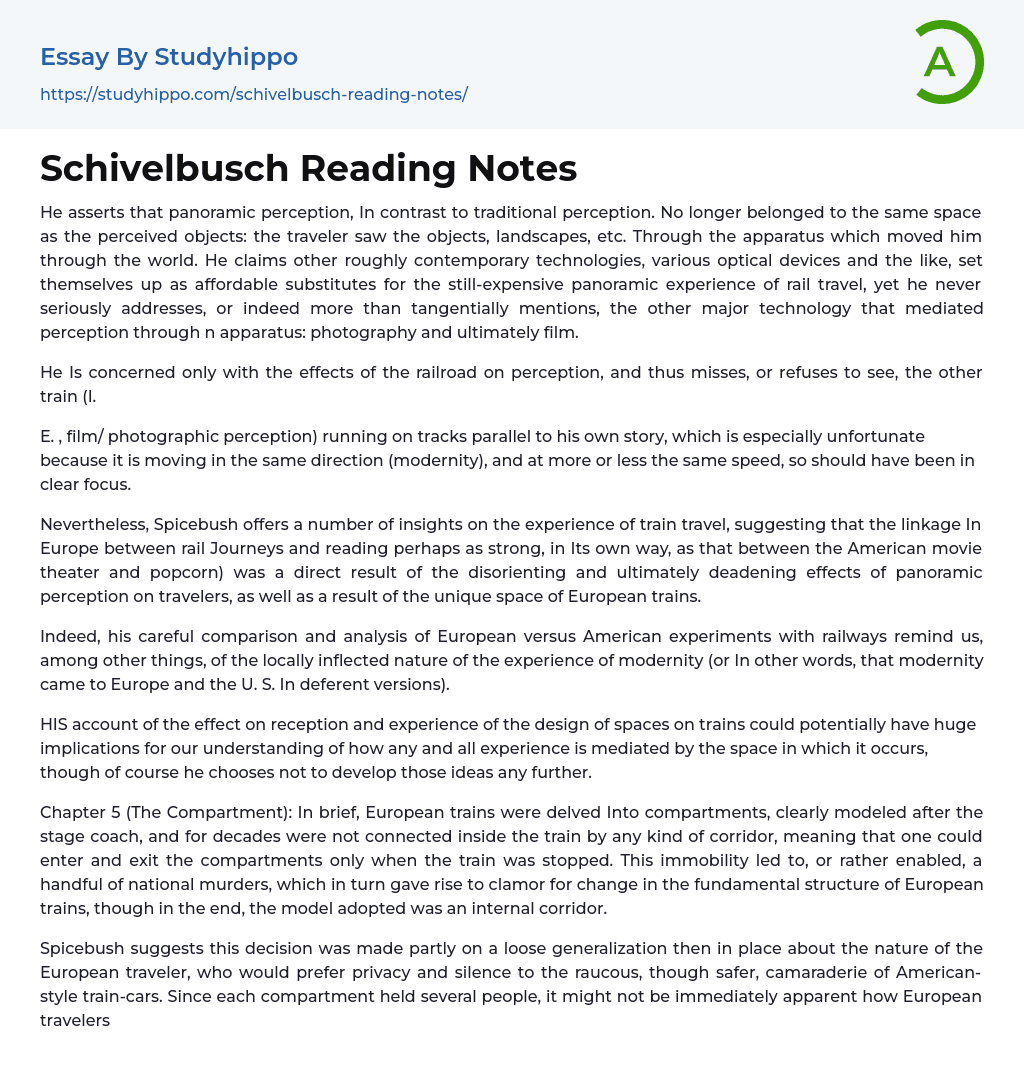The author argues that panoramic perception differs from traditional perception in that it no longer exists in the same space as perceived objects. Instead, the traveler views landscapes, objects, and more through an apparatus that moves them through the world. Despite the availability of other affordable optical devices, the author only focuses on the effects of rail travel on perception and fails to address the major technology of photography and film that also mediates perception. This is a missed opportunity because both technologies move towards modernity at similar speeds. Nonetheless, the author of Spicebush offers valuable insights into train travel. They suggest that the connection between reading and rail journeys in Europe is similar in strength to that of popcorn and American movie theaters due to the disorienting and deadening effects of panoramic perception on travelers and the unique space of European trains.Th
...e author's examination of railway experiments in Europe and America highlights the distinctive variations in the experience of modernity between regions. Additionally, the analysis of how spatial design influences train travel experiences could have significant implications for understanding all human experiences. Chapter 5 focuses on the compartmentalization of European trains, which lacked interior corridors causing stops to be necessary for entry and exit. This arrangement enabled a few national murders and ultimately resulted in calls for structural change. Spicebush posits that the adoption of an internal corridor was influenced by a broad stereotype that European travelers preferred privacy and quiet over the conviviality found on American trains, which were safer in contrast.The presence of multiple individuals within each train compartment may have made it seem improbable for European travelers to achieve peacefulness an
competition. However, due to the quicker travel time provided by trains (compared to coaches), passengers were no longer compelled to socialize, instead opting to read as a means of breaking the awkwardness. Additionally, medical professionals at the time believed that focusing on reading (as opposed to merely giving the appearance of reading or reading casually) would strain both the eyes and the mind further due to the already-stressful conditions of train travel. These ideas about perception ultimately resulted in a surge in newspaper sales and a decrease in purchases of books for train journeys throughout Europe. Despite America being perceived as the new and modern counterpart to Europe's old world, Spicebush argues that this generalization can be grounded in specific quirks of each place's economic and geographic facets. One crucial insight of Spicebush's is that rail lines in America were not as straight and level as they were in Europe.In Europe, labor was abundant but land was expensive, while in America, land was cheap and labor was scarce. This led to significant technological differences, as rail lines in the U.S. were built around obstacles rather than through them, saving on labor costs. Unlike in Europe where railroads were straight, the need for curved tracks in the U.S. allowed for the development of a new relationship between track and train car. This facilitated the creation of larger trains without compartments. American trains also needed to have onboard amenities such as restrooms and food since they often traveled through uninhabited areas without access to stations. In contrast, Europe's more densely populated areas allowed for train stations with full amenities along each route.
The spatial design of European
trains was influenced by the stagecoach, which was widely used thanks to good roads. On the other hand, American trains followed the example of riverboats due to the country's underdeveloped road system. This fundamental difference had a significant impact on the development of train cars. American train cars featured rows of seats and open spaces, which encouraged communal discussions and created a more egalitarian environment. In contrast, European trains had well-upholstered compartments for higher-class travel and compartmentalized space.
Passengers eventually learned to internalize new ways of seeing in response to the mechanization of perception caused by trains. The speed of the train became a source of aesthetically pleasing experiences, rather than causing the landscape to disappear.The concept of 'panorama' was deemed a fitting name to capture the new experience as it referred to the popular optical gadget that displayed images in rapid succession. The characteristic that set panoramic vision apart was that it no longer experienced evanescence, but rather, evanescent reality had become the new reality. To cope with the proliferation of visual stimuli while traveling, passengers developed new habits such as reading, which was previously unthinkable in the stagecoach designed for intense conversation. However, due to the increased number of passengers in each carriage, interaction in small groups became difficult and reading emerged as a practical way to neutralize the discomfort of silence.
- Reading Books essays
- Consciousness essays
- Intelligence essays
- Mindset essays
- Perception essays
- Problem Solving essays
- Resilience essays
- Coaching essays
- Critical Thinking essays
- homework essays
- Learning essays
- Library essays
- Listening essays
- Literacy essays
- Mentor essays
- Physical Education essays
- Project essays
- Reading essays
- Research essays
- Sex Education essays
- Social Studies essays
- Standardized Testing essays
- Study Plan essays
- Teaching essays
- Agriculture essays
- Albert einstein essays
- Animals essays
- Archaeology essays
- Bear essays
- Biology essays
- Birds essays
- Butterfly essays
- Cat essays
- Charles Darwin essays
- Chemistry essays
- Dinosaur essays
- Discovery essays
- Dolphin essays
- Elephant essays
- Eli Whitney essays
- Environmental Science essays
- Evolution essays
- Fish essays
- Genetics essays
- Horse essays
- Human Evolution essays
- Isaac Newton essays
- Journal essays
- Linguistics essays
- Lion essays




